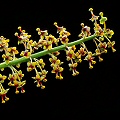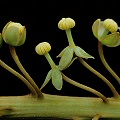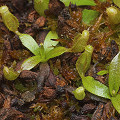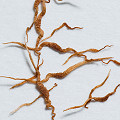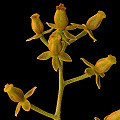Q: Nepenthes: advanced cultivation
A: Here are a few details on Nepenthes
cultivation that are a little more advanced.
Mind you, I am not going to spend time telling you how to grow things like ultra-difficult species, or how to build a
cooling chamber for Nepenthes villosa. That is a little beyond what I want the FAQ to cover. Join
the International Carnivorous Plant Society and read back issues of Carnivorous Plant Newsletter for stuff like that.
If you wish to make Nepenthes seeds, you must
have a male plant and a female plant flowering at the same time.
Vegetative propagation: I have good luck making cuttings from many species. First, cut a stem off a plant. The best cuttings
come from stems that have green surfaces. If the stem is woody and brown, your success rate will be lower. Cut the stem into
segments, each having about two leaves on it. Trim each leaf to about 1/3 its full size. Bury the bottom half of the cutting
in planting medium (whatever works well for you), then put the pot in a plastic baggie in 100% humidity and normal light
levels. Rooting will occur within a month or so, but some recalcitrant species may take several months to root.
Some growers root the cuttings in pure water. Sometimes rooting hormone is helpful. I have been told that it is actually best to
trim the leaves back about a week before making the cutting, but I have not yet explored this. However, I have performed experiments
and measured statistically significant enhanced rooting success when I make the stem cuttings under water. Apparently it prevents
cavitation in the stem, or at least that is my guess.
Sexual propagation: If you want to produce seed, you will need pollen from a male plant, and a receptive female plant. I have heard conflicting reports
on how long the pollen can be stored and stay viable. I would keep the pollen, dry, in foil packets in my refrigerator if I
were going to store it. Seed is produced within a month or so from pollinated plants. The seed are long, almost threadlike, and
should be planted immediately with no special treatment. Germination should occur within a few weeks, although I had some seed
take six months to germinate. This is surprising, since seeds lose viability rapidly.
Pests: Scale, thrips, and other arthropods can cause problems on Nepenthes,
and if you cannot pick them off, you can try Imidacloprid. Yeah, it's a neonic, but it's flowers are gnat pollinated, so you're unlikely to screw
around with bees.
Weird soil mixes: Examples of other soil mixes that people try on their beloved Nepenthes include
pure Sphagnum, inorganic mixes such as clay pellets, charcoal, and coco peat (aka coir). I cannot
say I have used any of the really strange mixes with much success. I keep returning to pure Sphagnum
or Sphagnum: aggregate mixes.
Page citations: D'Amato, P. 1998a; Rice, B. 2006a; Rischer, H. 2000;
personal observations.
